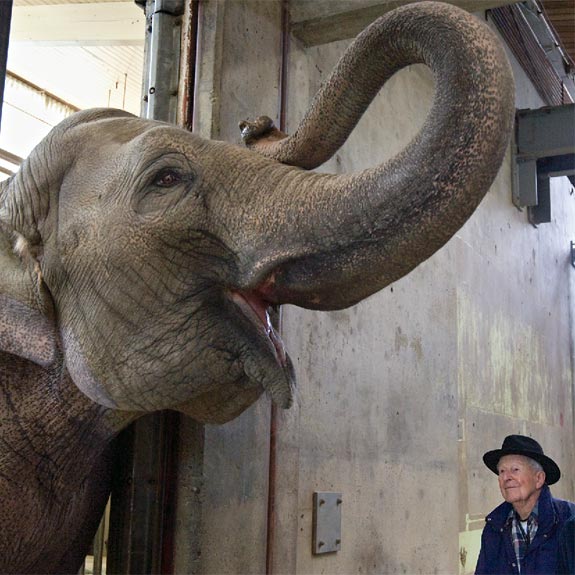Rose-Tu warily eyes the stranger shuffling toward her. He is moving slowly and grasping the arm of a human she sees almost daily. As Matthew Maberry (D.V.M. ’47) plants his cane inside the Oregon Zoo’s elephant compound, he lifts his eyes and returns the look.
“The only trouble with elephants,” says Maberry, the Portland zoo’s first staff veterinarian, “is you can fall in love with them.”

Maberry—”Doc” to some—is eager to get started. Now up close to Rose-Tu, the 90-year-old presses an instrument against the elephant’s wrinkled belly. Inside, the first Asian elephant baby to be born at the zoo since 1994 is finishing its second year of gestation.
“How much time do you reckon?” asks Mitch Finnegan, the zoo’s current lead veterinarian.
“I think it’ll be September, probably around the first, because she’s changed so much (since) the time I saw her before,” Maberry replies.
“It’s nice to talk to someone who’s been there,” Finnegan says. “There’s a lot of experience people get by living through pregnancies that tell you a lot more than simple blood work.”
“Other than that,” Maberry concludes his exam with a grin, “I think you’re going to be on your own.”
Doc Maberry was very much on his own in 1962. With the nation watching, and little documented information about birthing elephants in captivity, Maberry cared for a pregnant elephant named Belle. He practically lived in the elephant facility during the last months of her pregnancy.
That spring, a precocious 225-pound calf named Packy become the first Asian elephant born in the Western Hemisphere in 44 years. The hairy calf was an instant celebrity, attracting rock-star-level throngs to the zoo. Even today, at 46 and more than 13,000 pounds, Packy still is the zoo’s best-known attraction and North America’s tallest and oldest bull elephant.
Matthew Maberry grew up on his family’s dairy farm in Sequim during the Depression and was a bookish kid who completed his high-school curriculum at age twelve. He was turned down at the University of Washington’s medical school for lack of money so he hitched a ride to Pullman aboard a fish delivery truck and talked his way into the veterinary program at Washington State.
After graduating, Maberry landed a job as a veterinarian with the city of Portland in the 1950s, which then operated the Portland Zoological Gardens, where “the only thing that was holding it together was the smell,” he recalls. The zoo moved to nicer quarters in Washington Park before Packy’s birth.
Thanks, in part, to Packy’s success, the zoo became a world leader in elephant breeding, research, and species preservation. “Now I realize how lucky I was that (Maberry) created that environment,” says Mike Keele, also an elephant expert and the zoo’s deputy director.
Back in the day, Maberry became a celebrity, too. He was featured in Life magazine and was a popular speaker for civic and school groups. But while Packy’s fame lasted over the decades, Maberry’s spotlight faded. In 1973 a herpes virus carried by an African green monkey nearly killed him and left him bed-ridden for a year. During his illness, the zoo’s controversial director at the time pressed him for a resignation, which he reluctantly tendered.
After leaving the zoo, Maberry resumed a private practice and found that his life was anything but ordinary, whether he was helping capture sea mammals in North America or monkeys in the jungles of Bangladesh.
Trade show producer Bob O’Loughlin hired Maberry to help capture killer whales and other animals for boat shows and sea aquariums long before the days of Keiko, the whale that starred in movie Free Willy. “You name it,” O’Loughlin recalls of their wildlife adventures, “we were chasing it.”
Maberry made house calls well into his eighties and still monitors the health of harbor seals at the Seaside Aquarium on the Oregon Coast. He lives quietly in a tidy suburban ranch-style house in Beaverton and spends his days surrounded by wife Pat’s flower gardens. He seldom talks about his adventures because few people have asked.
Until now, that is. Pat Maberry decided her husband was an ideal candidate for WSU’s Distinguished Veterinary Alumnus Award for Outstanding Service. He not only won that honor, but also garnered achievement awards from the Oregon Veterinary Medical Association and the Metro Council, which oversees the zoo and other regional government services. Maberry has since renewed acquaintances at the zoo and helped promote its $125-million improvement bond measure.
“To have someone like that to be so loyal, so passionate about the zoo says a lot,” says Keele.
Throughout his career, Maberry seldom passed up opportunities to teach the world about wildlife, but did turn away from the possibilities of becoming a university professor or settling down enough to build a lucrative veterinary practice.
“I never had the dollar sign in front of my eyes. I could’ve done a lot of things that made a lot of money,” he says. Instead, “I got to live a life that most people dream about.”
On the Web:
Archival video of Packy’s birth in 1962 (Oregon Zoo)
